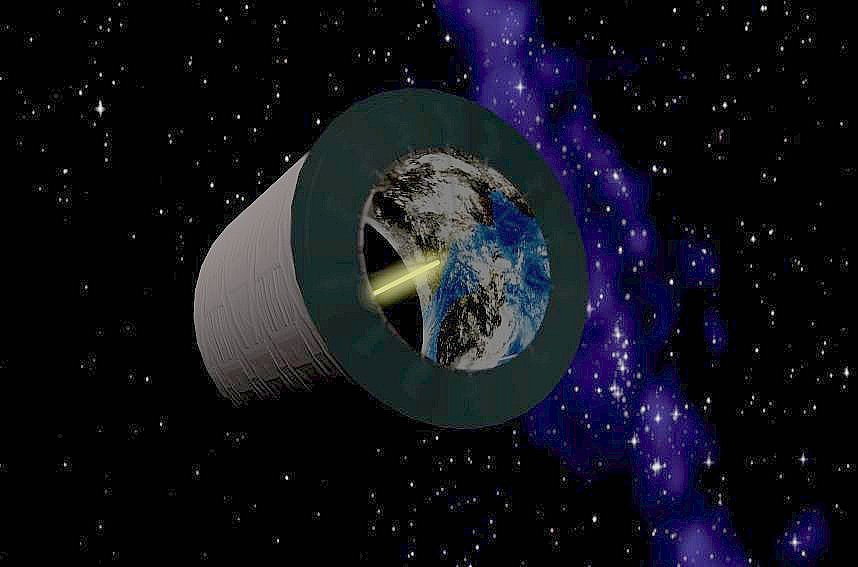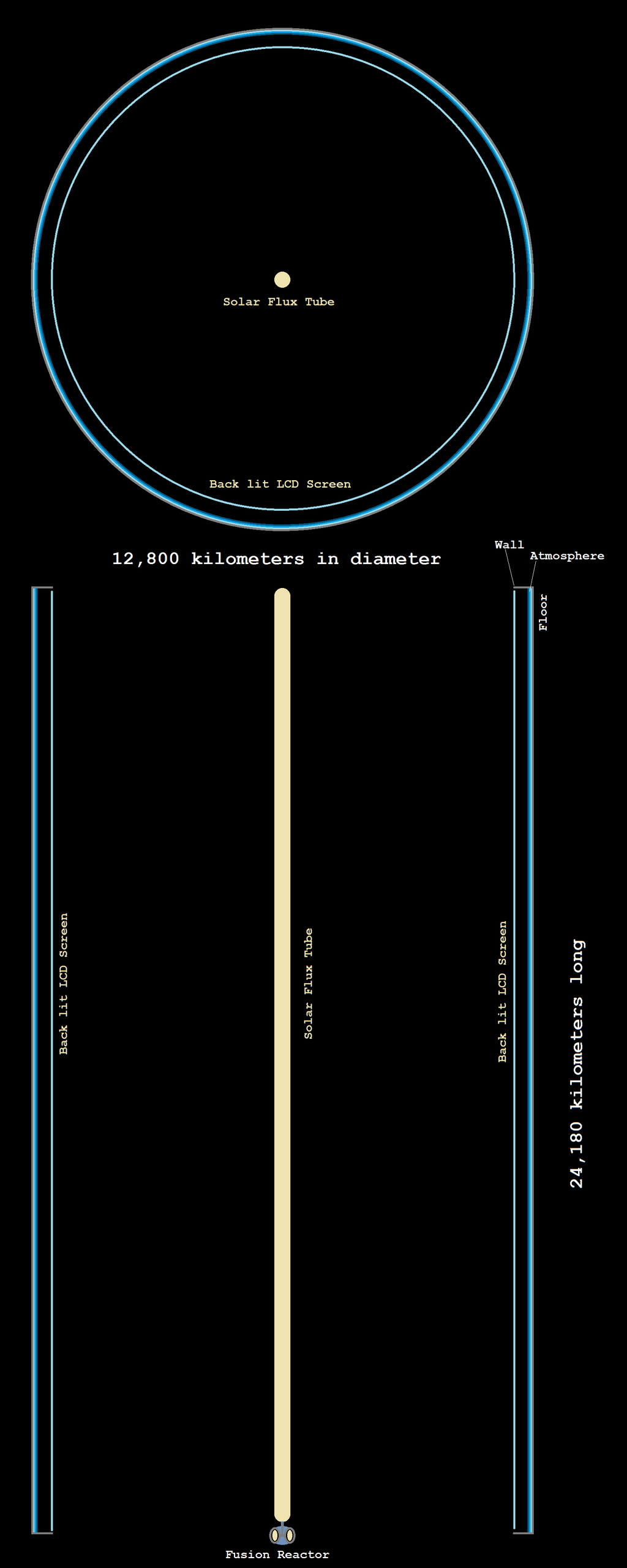New Mars Forums
You are not logged in.
- Topics: Active | Unanswered
Announcement
#1 2017-04-28 09:47:47
- Tom Kalbfus
- Banned
- Registered: 2006-08-16
- Posts: 4,401
Practical Dyson Sphere: The keu to terraforming the Solar System

Imagine this but completely covering the Sun, this sphere itself is not a place we live, each strip would overshadow ones further out, but the sum total of them all would completely envelope our sun, the purpose of this would be to collect the Sun's energy.
This article has some details about how a Dyson Swarm might be constructed.
I say we should make a Dyson Swarm that is only half an AU in radius, the purpose is not to live inside of it, but to collect energy. We take apart Mercury. Mercury has a mass of 3.3011×10^23 kg. A Dyson Sphere with a radius of half an AU is about 75,000,000,000 meters in radius. The total area to be covered is 7.06858347057703e+22 square meters. Divide the total mass of Mercury by the surface area of this half-sized Dyson Sphere and we get 4.67 kilograms per square meter of the Dyson Sphere, this would collect a lot of energy, but would leave the rest of the Solar System in the cold, unless we beam energy in the form of laser light to the planets and settlements. The problem with most of the worlds in the Solar System is that they are the wrong distance from the Sun. we can fix that. Each solar collector would collect energy on the sunward facing side of each panel and it would also beam energy on the outward facing side to another collector further out, which would then reabsorb the energy and do the same beming energy further out until we get to the outermost solar collectors in the swarm. Each collector would be in an independent orbit around the Sun, but when facing a certain direction, it would beam energy to certain planets and worlds in the Solar System. It would beam just enough energy to Venus to equal the solar intensity per unit area received by the Earth, it would also beam energy to the Earth and the Moon, and it would beam energy to Mars and to each of the asteroids, and to the entire Jupiter, Saturn, Uranus, and Neptune System. It would beam energy to Kuiper belt objects including dwarf planets, and any other currently unknown worlds that are out there. An array of lasers would be combined by a collator in between the laser arrays and the world to create synthetic sunlight, the collator would appear as a solar sized disk to the world being transmitted to. These lasers would be similar to the ones proposed to drive light sails to appreciable fractions of the speed of light for interstellar voyages, an some of those lasers in this Dyson swarm would be used for that. Finally Oort cloud objects would be tracked and illuminated by these lasers as each one is discovered. 
There could be ultimately thousands of worlds within the gravitational influence of the Solar System, as for the artificial habitats the World Ring would be the largest one practical, it can provide Earth normal gravity and an Earth like environment when we run out of natural worlds to terraform. I would suggest that instead of using magmatter as the fictional Orionarm article suggest, we use embedded and magleved nonrotating ring components to buttress the rotating part or each World ring. These world rings would be mostly in the outer portions of the solar system and receive beamed energy from the central Dyson Sphere.

You know the funny thing is, I proposed this idea to them! They were really nasty to me at the time, they tried to belittle me, they have such huge egos, but they didn't mind taking this idea from me. That picture they had, didn't exist when I first proposed this idea, they had an artist paint it, this blueprint I drew above I made. So its really amazing how an idea will spread when you don't take credit for it. Just saying.
Last edited by Tom Kalbfus (2017-04-28 10:48:01)
Offline
Like button can go here
#2 2017-04-30 12:16:41
- karov
- Member
- From: Bulgaria
- Registered: 2004-06-03
- Posts: 953
Re: Practical Dyson Sphere: The keu to terraforming the Solar System
The only practical Dyson Spheres are the Paul Birch supra- designs onto kinetic structures.
The inside-out 'classical' design relies upon 'gravity generators' which ... if we have grav-gens this is = to direct space-time control, so we won't need to terraform planets and stars but we'll build universes ![]()
Offline
Like button can go here
#3 2017-04-30 20:58:06
- Tom Kalbfus
- Banned
- Registered: 2006-08-16
- Posts: 4,401
Re: Practical Dyson Sphere: The keu to terraforming the Solar System
The science fiction design does, but the structure Freeman Dyson had in mind when he coined this term was not a solid object, but a cluster of such objects to absorb all the light of the star in order to harness its energy, there are a number of things which can be done with this energy, I have named a few. Terraform planets and moons, provide transportation between various places within our Solar System and beyond. This Dyson would have a number of spotlights to deliver solar energy to various places, it intercepts one billion times the energy received by the Earth, and small portion of it can light up the Earth to keep things just the way they are, we can illuminate Venus, so as to maintain an Earthlike environment there, a spotlight can be shined on Mars, each of the asteroids in the asteroid belt can similarly be illuminated by spotlights from the sphere, no need for mirrors to concentrate light. The entire Jovian System can be lit up, 3 of the Gallilean satellites will likely end up with carbon dioxide atmospheres surrounding global oceans. At the distance Jupiter is from the Sun, much of the ice on the surface of Europa, Ganymede, and Callisto will be dry ice, that will sublime into an atmosphere of carbon dioxide surrounding a bubbly ocean of water.
Saturn will be illuminated, its icy rings would dissolve in the vacuum of space leaving behind rocky material, Titan would melt, giving it a nitrogen/carbon-dioxide atmosphere, the smaller moons would turn into giant comets with long tails. I wonder what would happen to Saturn itself, its upper atmosphere would warm up, water clouds would rise to higher elevations, some interesting chemical reactions will occur.
Uranus and Neptune would more easily be terraformed, maybe become true water worlds with endless oceans. Uranus would be a strange place if it keeps its tilt.
Offline
Like button can go here
#4 2017-05-06 11:21:13
- Tom Kalbfus
- Banned
- Registered: 2006-08-16
- Posts: 4,401
Re: Practical Dyson Sphere: The keu to terraforming the Solar System
A Dyson Sphere is mainly to collect energy from the central star, think of it as a giant fusion reactor. Popular Science has an article about Dyson Spheres, their Dyson Sphere is a swarm of solar collectors in different overlapping orbits to intercept all of the star's energy, those collectors then beam energy to one another, and then beam it to where its needed. A ringworld can also be a part of this, as human habitats would be included and be one of the many places that receives energy from the Dyson Sphere. My idea of a Dyson Sphere + Ringworld is to have a Dyson Sphere the size of the orbit of Mercury. Mercury is taken apart to build the Dyson Sphere at about 2 kilograms per square meter, the next orbit out is Venus, and beam of energy reaches out to Venus to give it an Earth level of sunshine, it is terraformed and a pleasant place to live. The Earth is much as it is today, next out is the ringworld, it spins at an inclined angle to the ecliptic at a radius of 100 million miles, well outside the radius of Earth's orbit so as not to interfere, beyond the Ringworld is Mars, it is fully terraformed has a breathable atmosphere and is illuminated by a beam of light from the Dyson Sphere that is just enough to keep it warm and habitable. the asteroids are a bunch of space colonies that are illuminated by multiple beams of light from the Dyson Sphere. Jupiter is missing, much of its mass was used to make the ringworld. Saturn and its Satellites, plus those of Jupiter, now orbit Saturn, so it has 5 large Moons, all of them are terraformed, there is a solid sphere around Saturn itself and its outer surface is terraformed. Most of the gaseous atmospheres of Uranus and Neptune were removed, what remains are two Earthlike terraformed worlds illuminated by beams of light from the Dyson Sphere, the Dyson makes sure each body gets enough light so that it remains a habitable place for humans to live. that is how I see the future of our Solar System.
Offline
Like button can go here